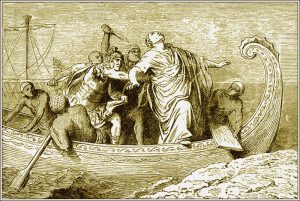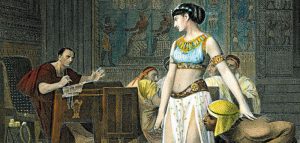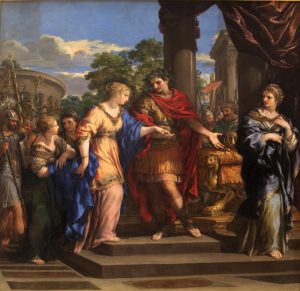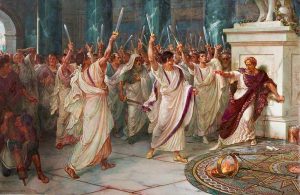From 49 to 45 BC, Julius Caesar was engaged in a civil war with his rival and former co-triumvir, Pompey. Pompey won the Battle of Dyrrhachium in 48 BC, but Caesar triumphed over him at the Battle of Pharsalus later in the same year. Pompey fled to Egypt to seek refuge from Ptolemy XIII, the son of one of his allies, Ptolemy XII.
Meanwhile, Cleopatra VII was the daughter of the former pharaoh Ptolemy XII Auletes and an unidentified woman. It is rumored that her mother was Cleopatra V, the sister, and wife of Ptolemy XII. After her father’s death, she co-ruled Egypt with her younger brother Ptolemy XIII.
Ptolemy XIII aimed to become the sole ruler of Egypt, and in the attempt to gain an advantage over his sister he had Pompey killed by Achillas and Lucius Septimius. This was a move to gain the favor of Julius Caesar, thus gaining a military advantage over Cleopatra. Once Caesar reached Ptolemy XIII’s palace, Pompey’s head was already waiting for him. He was in tears upon seeing his former foe decapitated and killed his assassins.
How Julius Caesar and Cleopatra Met
The way Julius Caesar and Cleopatra VII met was a popular story that even became the subject of a painting by Jean-Léon Gérôme in 1866 entitled Cleopatra and Caesar. It was rumored that Cleopatra was not allowed by her brother-husband to meet Julius Caesar and so she had herself carried to his bedchamber secretly rolled in a carpet by one of her trusted servants. Once the servant arrived in Caesar’s private room she unfurled the carpet in front of Caesar, presenting the queen to him. This manner of greeting Caesar was much more well-received than Ptolemy XIII delivering him the head of Pompey. Thus, Caesar and Cleopatra formed an alliance that served both parties well.
Julius Caesar and Cleopatra’s Relationship
Caesar and Cleopatra’s relationship was of romantic nature but it also had its political reasons. Cleopatra needed Caesar’s armies to protect herself from Ptolemy XIII while Caesar needed Cleopatra’s impressive wealth to fund his armies and resources, thus gaining power back in Rome.
Due to Egypt’s nature as a Roman client state, Caesar was able to declare once again that Cleopatra and Ptolemy XIII were both co-rulers of Egypt. Ptolemy XIII sensed Caesar’s favor for Cleopatra over himself and rejected the idea. He besieged both in the palace in Alexandria. During the months in which the lovers were trapped in the palace, Cleopatra’s sister, Arsinoe, started her own revolt against Cleopatra and Ptolemy XIII.
Once Caesar’s soldiers stepped foot in Alexandria, they were able to free the pair. In 47 BC, Caesar’s army was also able to defeat Ptolemy XIII in the Battle of the Nile resulting in Cleopatra’s rise to pharoah. In order to celebrate their victory, the couple had a fluvial procession on the Nile river in a royal barge which displayed to Caesar just how extravagant the Egyptians could be. Despite Caesar returning to Rome shortly after, Cleopatra was already with child before he left.
Caesar and Cleopatra continued their romance even if Caesar was already married. He could not marry a foreigner as it was not permitted by Roman law. However, they had a child together: Caesarion. Cleopatra visited Caesar in Rome a year after giving birth to his son. She stayed at one of Caesar’s estates not far from Rome, near the Tiber. She also enjoyed Caesar’s lavish gifts such as a golden statue in her image which Caesar displayed in Rome.
Julius Caesar’s Assassination
When Caesar was killed after heading to meet the Senate on 15 March 44 BC, Cleopatra left Rome. She felt uncomfortable staying in her estate without her lover. The next time Cleopatra came into contact with someone connected to Julius Caesar was during her love affair with Mark Antony in 41 BC.



